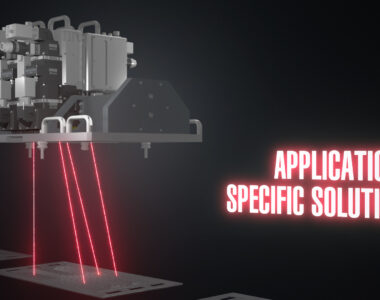New laser processing system for faster and better processes
27. Jun 2023

In future, Scansonic will be offering its customers a completely novel approach for cost-effective parallelization of laser processes and therefore for particularly high welding speeds: the FCW (Fast Component Welding) system technology. With this new technology, an extremely compact number of scanner units can be appropriately arranged on a single process-specific application plate. This means that several components can be processed simultaneously, which results in higher output within the same time. Alternatively, the system’s extended scan field allows larger components to be processed in a single step. The scanner units can be controlled individually and work cooperatively. This enables simultaneous, independent process control strategies at a high level of quality.
Faster. Better. Quality-assured
The new system is Scansonic’s response to the increasing speed and quality requirements in laser processing. The global effort to reduce emissions is accompanied by a growing demand for efficient fuel cells, batteries, electric motors and high-performance electronics, as well as cooling technologies. This also requires new laser processing techniques, for example for laser welding of bipolar plates, battery contacts, hairpins or surface coolers for car battery trays in electric vehicle drives.
At the same time, requirements for welding speed are high. For example, a single bipolar plate requires welds of a total length of up to 4.5 m; for a chiller plate, this can be up to 100 m. An electric motor consisting of up to 400 hairpins or battery trays with up to 1,000 battery cells with anode and cathode welding requires up to 2,000 welds. The joint must also meet high standards. Most components and therefore each seam section must be helium-tight. If a single individual seam is not OK, the entire component needs to be scrapped. This is why users expect the highest quality in terms of electrical, mechanical and structural component properties.
Higher productivity with FCW technology
This is exactly where Scansonic’s new FCW technology comes in. The scanner units can be combined in multiples, either in series or as a matrix. They therefore offer a large scan field, fast mirror movements, a powerful z-shifter for height compensation in the workpiece, automatic image recognition and sophisticated quality monitoring.
Using the example of bipolar plates and surface coolers for car battery trays as an example, this arrangement means a significant increase in the effective welding speed, as several seams can be welded simultaneously. When welding hairpins, the scanner units can be arranged at 90°. Each unit can approach a segment on the stator, illuminate it evenly, detect its position and weld it out. This means that the stator no longer requires turning, irrespective of its size. Turning the stator is not only costly, but also a determining factor for process productivity.
With the FCW system technology, Scansonic offers plant and mechanical engineers both a standardized and pre-adjusted laser welding system, which simplifies automation and individual adaptation on site while at the same time shortening work processes.
